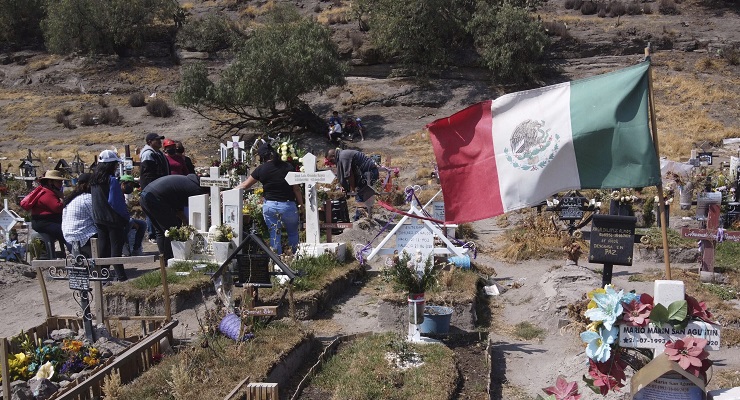
On a warm spring day last year, I met visual journalist María Fernanda Ruíz outside my apartment building. Our faces covered in cloth masks, our backpacks laden with hand sanitiser, extra face shields and photography equipment, we bundled into a car and drove to Xochimilco, a borough of Mexico City some 30 kilometres south of the central part of the megalopolis where we both live.
It was October 30, the weekend of Day of the Dead, and we were off to tell a story for ABC News about the COVID-19 pandemic in Mexico. In a municipal cemetery, we met the wife and children of a man who had died at the age of 45, his grave among many dug in May and June as the first wave of the virus swept the city.
At one of the embarkment docks for the famous Xochimilco canals, we met a boat driver with hopes that plan B or C or D would come through to feed his family while his per-boat-ride, cash-in-hand job had slowed since tourist numbers declined.
That was just over three months ago, when the death toll from COVID in Mexico was about 90,000 and the national economy was on its way to contracting by at least 10%.
After coming home that day I sat in the doorway of my apartment and looked up at the nearly full moon. Like Sara Sidner, the journalist we saw recently weeping on CNN, I felt heartbroken.
I wondered how I could, or should, convey all this in a factual news report for an Australian audience.
Since the pandemic began and the numbers of cases and deaths climbed and climbed in Mexico — there are now more than 160,000 dead and hospitals are straining to cope or worse — I have wondered how to even begin to explain the pandemic to people in Australia, where an entire city will close down until infections get to zero, and economic support from governments and employers allow that.
How to particularise and honour the stories of individual people, families and communities as the numbers rise and rise and rise.
How to avoid common international reporting tropes in which Mexico — as a so-called Third World country — appears inevitably doomed because it’s endemically poor.
How to show the normalcy and adaptivity of life inside deep structural injustice without saying that anybody should accept it.
It is my colleagues in Mexico who have helped me answer these questions. I’ve been fortunate to become a part of local media networks such as Frontline Freelance Mexico and to work with people like Fernanda Ruíz who have a much longer and deeper experience of reporting catastrophe and connecting it to the bigger picture, and who fight hard for the conditions in which to do it.
The story in Xochimilco marked the first time since March that I had done any field reporting. A freelance journalist reporting for outlets in the US and Australia, I have been able to report assignments by phone and pitch for comment pieces and research work, and thus stay more or less afloat from the confinement of my apartment.
But for most of my Mexican colleagues, especially those who are also freelancers — and especially photographers and videographers — staying home during this pandemic has not been an option. There has not been any stringent lockdown in Mexico; nor is there any support from employers or the government to maintain an income while taking stay-at-home measures.
As the independent media organisation Periodistas de a Pie reported in November, cutbacks in many agencies have further pressured journalists to show up for work in dangerous conditions.
The physical and economic exposure and emotional toll of covering the pandemic joins the risks that reporters already face in the deadliest country in the world for journalists. At least 90 Mexican journalists have died from COVID. An unknown number are suffering from the long-term effects of infection.
Spurred on by the heavy loss of life and livelihood in the industry, groups such as Periodistas de a Pie, Frontline Freelance, Article 19, and the Committee to Protect Journalists are organising for better working conditions.
As Jade Ramírez Cuevas Villanueva, one of the coordinators of Periodistas de a Pie, told Pie de Página in November: “Covering the pandemic is more than counting the number of sick, intubated and dead people.” It’s also about exposing and explaining “social inequality, diversion of resources, impunity and misuse of power”.
To express this is to make visible the circumstances in which independent, reliable news and analysis is produced for the public, so “that a person … has in mind, every time they read a story, a report or a live broadcast, that this journalist is perhaps experiencing stress, anxiety, precarious pay and a lot of conflict with his or her profession”.
Acknowledging this “is not only to appeal to emotions or to make them feel sorry for us, but also to make them understand why an essential job like this is worthwhile”.
In such a way, covering the pandemic alongside fellow journalists in Mexico has offered me a way of understanding it within an industrial reality that is faced by millions around the world, even as there is such a drastic breach between the warlike losses of the pandemic in Mexico and Australia’s doughnut days.
Ann Deslandes is an Australian freelance journalist and writer in Mexico City. Follow her on Twitter @Ann_dLandes







Crikey is committed to hosting lively discussions. Help us keep the conversation useful, interesting and welcoming. We aim to publish comments quickly in the interest of promoting robust conversation, but we’re a small team and we deploy filters to protect against legal risk. Occasionally your comment may be held up while we review, but we’re working as fast as we can to keep the conversation rolling.
The Crikey comment section is members-only content. Please subscribe to leave a comment.
The Crikey comment section is members-only content. Please login to leave a comment.